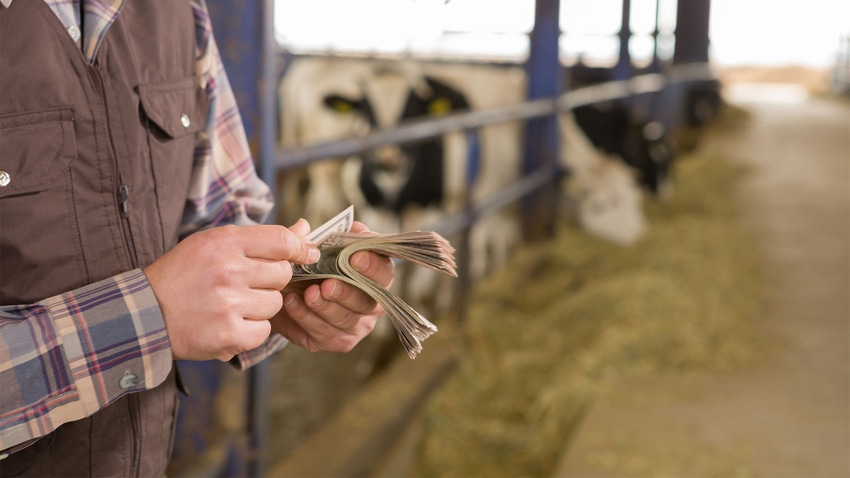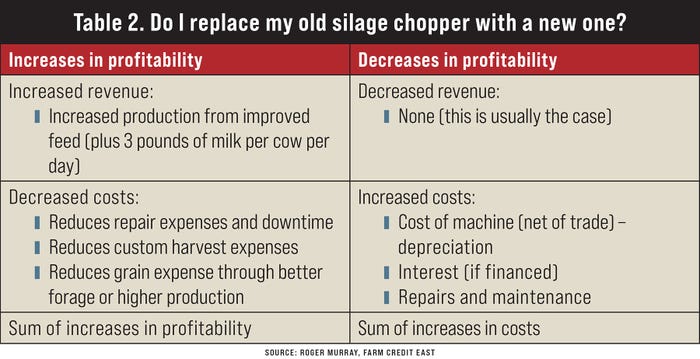April 4, 2024

by Roger Murray
Dairy farming has always been a capital-intensive business. There are a lot of fixed investments required to run a dairy farm.
Some of these fixed investments need periodic replacement or upgrading, and that’s just to maintain your current production level. If you want to grow and expand, even more capital investment is required.
Ranking priorities
The average American dairy farmer makes significant investments each year to maintain and upgrade their equipment and facilities. Unfortunately, it seems there are always more capital investments needed than funds available to make them.
So, how should you prioritize? What investments should come first?
One way to help answer that question is through a process known as partial budgeting.
Partial budgeting is a tool for determining the effect of an investment on the profitability of your farm. It involves asking several key questions shown in the tables below:


In a real example, you would try to put numbers to these increases and decreases and determine the net benefit or cost. You should also consider correlated investments. For example, does replacing the chopper also require the purchase of a larger tractor? What about trucks to haul feed versus wagons? Sometimes making one investment will lead you down a path where more and more investment is required.
Perform a sensitivity analysis
Once you’ve “penciled out” your assumptions, you will likely realize that these are not always known with certainty. In the example above, the improved efficiency of a new chopper is uncertain. It could be more or less than our assumptions.
The cost of the machine should be known, but the net savings in repair costs are difficult to precisely determine. The value of reduced downtime and enhanced reliability is hard to quantify. This is where sensitivity analysis comes in.
Range of outcomes
Sensitivity analysis refers to a process where you look at how changes in your assumptions affect the outcome of the analysis. If the capital investment in question is significant, and there is a great deal of uncertainty, you may wish to work through several partial budget scenarios — such as “worst-case” and “best-case” — and see how they differ. The greater the unknowns, the more these two scenarios will diverge.
Some benefits of an investment can be hard to distill into dollars and cents. One example is the reduction in downtime and repair hassles, referenced in the tables above. Another could be improved safety.
Finally, partial budgeting typically does not consider changes in risk. These are still important factors to consider. You may wish to include a hypothetical figure to factor in the value of these intangible benefits. Even with some unknowns, it’s still worth going through the exercise of partial budgeting as a decision tool.
Risk and opportunity costs
Another consideration given finite resources — making one investment today, whether with cash or borrowed funds, limits your flexibility to make another investment next year. Sometimes it makes sense to postpone a capital investment, even one with a positive return, in favor of maintaining liquidity or available credit for a future, perhaps yet unknown, investment that may be more urgent.
On most farms, there are more projects in need of investment than there are funds available. You will need to prioritize investments and determine what should be done right away, what can be put off for a while, and those projects that just aren’t in the cards at this time. This is where partial budgeting can be useful.
Analyzing the capital investments you may be considering can be illuminating. Be honest and make sure you are considering all the options. Are there “sacred cows” that should be reviewed and possibly sacrificed to take on the big project?
Many times, farms are faced with several competing investments, all of which might be worth doing at some level. Given limited resources, partial budgeting can help you determine the ones to prioritize and the ones that can wait.
Murray is executive vice president and chief marketplace officer for Farm Credit East.
Source: Farm Credit East
You May Also Like




